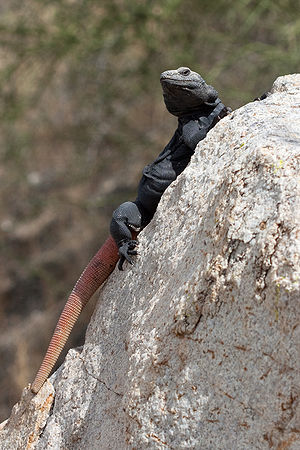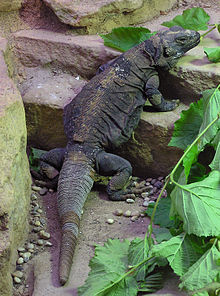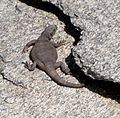- Sauromalus ater
-
Common Chuckwalla[1] 
Common Chuckwalla (male) Conservation status Scientific classification Kingdom: Animalia Phylum: Chordata Class: Sauropsida Order: Squamata Suborder: Iguania Family: Iguanidae Genus: Sauromalus Species: S. ater Binomial name Sauromalus ater
(Dumeril), 1856
Approximate range of Sauromalus ater The Common Chuckwalla (Sauromalus ater) is a species of lizard in the family Iguanidae. It inhabits the Sonoran and Mojave Deserts of the southwestern United States and northwestern Mexico. Its range extends from Eastern California, Utah, and Nevada south to Baja California and Sonora.[2]
Contents
Taxonomy
The common name "chuckwalla" (or chuckawalla) is derived from the Shoshone word "tcaxxwal" or "caxwal," the form used by the Cahuilla of southeastern California.[3]
Its generic name, sauromalus, is a combination of two Ancient Greek words:σαῦρος (sauros) meaning "lizard". and ομαλυς (omalus) meaning "flat".[3] Its specific name is ater, Latin for "black" or "dark"
Its original epithet was Sauromalus obesus; and although that name is no longer officially recognized, it is still very common in the literature and it remains in many standard natural history references for North America. In 1998, Bradford D. Hollingsworth examined variations in Sauromalus and concluded that only five species should be recognized. He regarded S. obesus as conspecific with S. ater, and he used S. ater, which has priority, as the specific name of the combined taxon.[4] No subspecies of S. ater are currently recognized.[4] Based primarily on the extensive use of the name S. obesus, a petition to give that name precedence over that of S. ater was submitted to the ICZN.[4] However this reasoning was dubious and the priority of S. ater was maintained.[4] In 2004, ICZN ruled that the name Sauromalus ater was first described by zoologist Auguste Duméril in 1856 and thus had precedence over the name Sauromalus obesus which was not named until 1858 by Baird.[4]
Description
The common chuckwalla is a large, flat-bodied lizard with a large rounded belly, and a wide-based blunt-tipped tail.[3] Reaching a total length of 40 centimetres (16 in) and a weight of .9 kilograms (2.0 lb).[5] Small scales cover its body, with larger scales protecting the ear openings.[3] The coloration of these lizards varies by location and between juveniles and adults, as well as among males and females.[3] In adult males, the head, shoulder, and pelvic regions are black while the mid-body is light tan speckled with brown.[3] Adult females are brownish in color with a scattering of dark red spots. Young chuckwallas have four or five broad bands across the body, and three or four on the tail which are lost in adulthood by males, but retained somewhat by females.[3]
Behavior
Harmless to humans, these lizards are known to run from potential threats.[5] When disturbed, the Chuckwalla will gulp air, distend its body and wedge itself into a tight rock crevice.[5] The Chuckwalla will inflate its body with air in order to entrench itself.[5]
Males are seasonally and conditionally territorial; an abundance of resources tends to create a hierarchy based on size, with one large male dominating the area's smaller males.[5] Chuckwallas use a combination of colour and physical displays, namely "push ups", head-hobbing, and gaping of the mouth to communicate and defend their territory (see animal communication).[5]
Chuckwallas are diurnal animals and as they are exothermic, spend much of their mornings and winter days basking.[5] These lizards are well adapted to desert conditions; they are active at temperatures of up to 102°F (39°C).[5] Chuckwallas brumate during cooler months and emerge in February.[5]
Mating occurs from April to July, with 5-16 eggs laid between June and August. The eggs hatch in late September.[5]
Diet
Primarily herbivorous, the chuckwalla eats creosote bush flowers, leaves, fruit, and occasionally insects.[5]
Gallery
References
- ^ "Sauromalus ater". Integrated Taxonomic Information System. http://www.itis.gov/servlet/SingleRpt/SingleRpt?search_topic=TSN&search_value=564596. Retrieved 15 September 2008.
- ^ Grismer, L. Lee (2002). Amphibians and Reptiles of Baja California, Including its Pacific Islands, and the Islands in the Sea of Cortés. University of California Press. p. 130. ISBN 9780520224179. http://books.google.com/books?id=3TgaUSd0lUQC&printsec=frontcover&client=firefox-a&source=gbs_v2_summary_r&cad=0.
- ^ a b c d e f g Schwenkmeyer, Dick. "Sauromalus ater Common Chuckwalla". Field Guide. San Diego Natural History Museum. http://www.sdnhm.org/fieldguide/herps/saur-ate.html. Retrieved 17 September 2008.
- ^ a b c d e Hollingsworth, Bradford D. (2004). The Evolution of Iguanas an Overview and a Checklist of Species. University of California Press. p. 42. ISBN 9780520238541.
- ^ a b c d e f g h i j k Stebbins, Robert C.,(2003) A Field Guide to Western Reptiles and Amphibians, 3rd Edition. Houghton Mifflin Company, ISBN 0-395-98272-3
External links
Categories:- IUCN Red List least concern species
- Iguanidae
- Fauna of the Sonoran Desert
- Fauna of the Mojave Desert
- Fauna of the Colorado Desert
- Fauna of Northern Mexico
- Reptiles of Mexico
- Reptiles of the United States
- Fauna of the Southwestern United States
Wikimedia Foundation. 2010.







